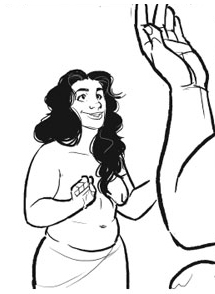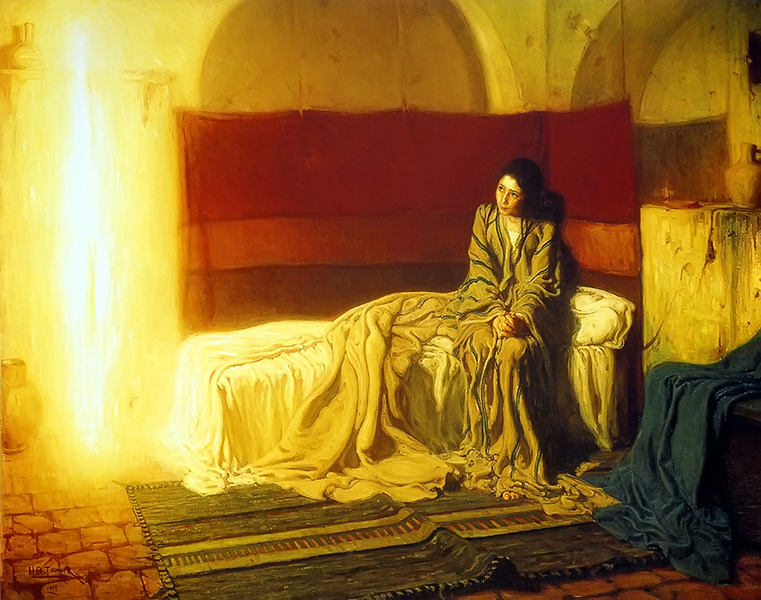She Who Shapes
Friday, March 18th, 2016“Who is that rising like the morning star,
clear as the moon, bright as the sun,
daunting as the stars in their courses?”
— Song of Songs 6:10, translated by Ariel and Chana Bloch
Note: This entry is inadvertently appearing just before catholic Easter (its orthodox counterpart is on May 1). It contains both what are euphemistically called “mature themes and language” and a detailed description of a story. But even for those who hyperventilate at the horrificity of “spoilers”, the story has to be seen for its full worth to be appreciated.
———-
 I don’t look at porn much (unless, as one of my readers pointed out, it crosses into erotic art). Almost all porn is geared to men’s pleasure; most is hostile to women. But, true to my unibrow tastes and principles, I will dip into anything I normally dislike if it comes recommended by someone whose judgement and taste I trust. Besides, porn is known to have given rise to artwork of the first magnitude, from Utamaro’s ukiyo-e and the Khajuraho sculptures to Klimt’s soft-gauze portrayals (and their savage Schiele counterparts).
I don’t look at porn much (unless, as one of my readers pointed out, it crosses into erotic art). Almost all porn is geared to men’s pleasure; most is hostile to women. But, true to my unibrow tastes and principles, I will dip into anything I normally dislike if it comes recommended by someone whose judgement and taste I trust. Besides, porn is known to have given rise to artwork of the first magnitude, from Utamaro’s ukiyo-e and the Khajuraho sculptures to Klimt’s soft-gauze portrayals (and their savage Schiele counterparts).
In one of my increasingly infrequent visits to Twitter, I bumped on Kay Holt’s shout-outs to comics. Kay knows her stuff and is no mean graphic artist herself. One item she named sounded intriguing: Smut Peddler 2014 from Iron Circus Comics, the successor to their well-received 2012 volume. I read an interview of Spike Trota, one of the anthology’s creators and editors. Something she said in that interview piqued my curiosity, so I bought SP2014 (which, in time-honored fashion, came wrapped in opaque black plastic).
The antho has about two dozen stories. They range far and wide in terms of combinations, body types and protagonist provenances. The quality of the stories (admittedly not the focus of such work) varies; the overall visual art, on the other hand, is uniformly excellent. The settings go from real-world to fantasy to science fiction – though the alien encounters are timid when compared to Hokusai’s Tako to Ama, still the best depiction of tentacle sex.
What makes SP2014 unique is its unabashed focus on women’s pleasure. Never before have I seen so much oral sex or lack of coercion in a single book dedicated to sex. But the antho has something more than evolved sexual mores. Tucked among the entries, just before the end, is a story that’s worth the price of the entire book by itself: Liza Petruzzo’s Clay. It’s a virtuoso performance that relies entirely on images, a seamless fusion of several mythic veins – and deeply subversive in the way it has chosen to tell a story that’s a cornerstone of christianity.
In the christian canon, Mary (Maryam) is the perfect passive vessel. She has no will or agency of her own, and is totally, unquestioningly obedient to male authority. She undergoes the ordeal of pregnancy and birth without knowing the ecstasy of either yearning or desire, and she becomes the conduit of what is essentially an affair between two male gods. In her person, monotheisms drained the power from the old, potent woman god whose son becomes first her lover, then a sacrifice to ensure that the cycle of fertility remains unbroken.
The great woman god is sometimes a virgin; sometimes she has many consorts. Her travails may end up in triumph or tragedy, but she’s never an afterthought or a channel. In stark contrast, Mary and her many incarnations are disposable, from the mother who lets her son rip out her heart in Balkan folksongs to Shmi Skywalker. Their best hope is to survive the miracle birth itself and be allowed to act as either pleading intercessors or unwilling collaborators to the dire unleashings of their sons, who have become their masters.
In art, the sand grain of Mary has produced a harvest of dazzling pearls – the Theotókoi of the east and the Madonnas of the west; the Akáthistos hymn and Easter laments of Byzantium (though the latter betray who she once was: they’re the barely-altered keenings of Astarte for Tammuz, Aphrodite for Adonis). Clay must be added to the outstanding works of Mariolatry, and to the dammed, hidden stream underneath it.
Clay starts mildly enough: a young woman gets up in the morning and heads to the nearby pond to take a bath. She’s full-bodied, plain-faced, her black hair cascading in unruly waves. She could be my mother’s sister or one of my father’s cousins in their youth. Her looks, clothing and implements place the story squarely in Bronze Age Mediterranean.
At the pond, behind the reeds, something is struggling and moaning. Parting the reeds, she sees an inchoate being – essentially a mount of clay – that reaches for her. As it looks scary and is several times her size, she’s naturally frightened. But it restrains itself before it reaches her… and intrigued and no longer afraid, she decides to shape it as Yahweh is said to have shaped Adam, as the rabbis of the diaspora tried to breathe life in their golems.
With care and joy, she fashions the creature into a handsome young man with hair longer than hers — the long swirls of the Minoan frescoes, the glorious mane that doomed Absalom. When made whole, he takes her in his new arms. They explore each other, and eventually he buries his face between her thighs until she climaxes.
When they’re finally standing up, caressing and tidying each other, the viewpoint pans out above them and you see their shadows, stretching before them in the morning light. Hers is her shape and height; his reaches the sky – and unfurls the mighty wings of the bene elohim, the sons of gods who came to the daughters of men. Yet as lovesome beings, they stand as equals. And as she shaped her lover, so will she shape the inchoate morsel his sweet tongue bequeathed her. For she is not nutrient soil, but a fearless Maker who makes her own choices.
In one fell swoop, Petruzzo reclaimed the lost power of the triple goddess and depicted the visual equivalent of that great, full-throated cry of mutual desire, the Song of Songs. If I were any of the churches whose adherents kneel before statues and icons of Mary, I’d use Clay as a conversion tool.
Images: top, Maryam (part of a panel from Clay, shown in Spike Trota’s interview in Comics Alliance); bottom, a more conventional Annunciation (though subversive in its own way) by Henry Ossawa Tanner (painted in 1898; Philadelphia Art Museum)
Related articles:
The Hyacinth among the Roses: The Minoan Civilization
Being Part of Everyone’s Furniture: Appropriate Away
The Andreadis Unibrow Theory of Art
Who Will Be Companions to Female Kings?
Mediterranean Diasporans: Dúrin’s Folk


